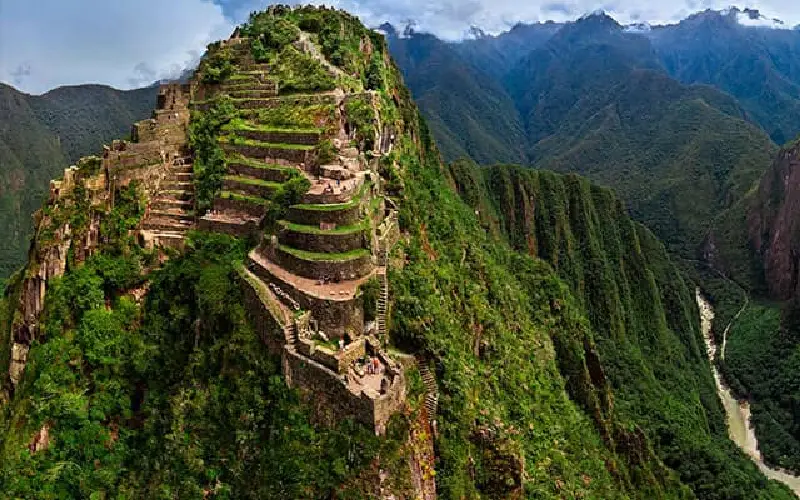Huayna Picchu Mountain is filled with Inca archaeological remains such as stairways, agricultural terraces, and the famous Temple of the Moon, a construction built inside a natural cave.
The trail leading to the summit of Huayna Picchu Mountain has, on one side, the rocky wall of the mountain and, on the other, a 200–300-meter drop to the bottom of the canyon, where you can see the Urubamba River in the distance. This naturally provokes feelings of fear and vertigo during the initial stages of the climb.
However, it is worth noting that despite the dangerous ascent and the sheer drops along the entire route, there are no official records of visitors who have perished on Huayna Picchu Mountain.
The mountain is composed mainly of rock, upon which the Incas carved their steps and paths to the summit, with a single trail used for both ascent and descent.
5 TIPS FOR CLIMBING HUAYNA PICCHU MOUNTAIN
1. What is the best time of year to visit Huayna Picchu Mountain?
The Inca citadel of Machu Picchu is located in the Cusco region, in southeastern Peru. This area has two distinct seasons: the rainy season, which usually begins in November and ends in late March, characterized by heavy rainfall across most of Cusco; and the dry season, which begins in late April and lasts until August or September.
At iteptravel.com, we recommend visiting during the dry season, as these months tend to have fewer cloudy days—perfect for taking stunning photos and avoiding the inconveniences of rain (mud, wet clothing, slippery paths). An advantage of the rainy season is the smaller number of visitors, giving you more space to explore this Wonder of the World.
2. How much does the ticket to Huayna Picchu Mountain cost?
The entrance ticket to Huayna Picchu Mountain costs an average of USD 75 and includes entry to Machu Picchu’s Royalty Circuit 3 or Lower Part + Huayna Picchu.
Tickets are not sold exclusively for the mountain.
If you have difficulties booking your Machu Picchu tickets, flights, or hotels, iteptravel.com has a team of tourism professionals with over ten years of experience who will gladly answer all your questions. Contact us at info@iteptravel.com.
3. How many tickets are available for Huayna Picchu Mountain?
The Ministry of Culture of Peru is responsible for the care and preservation of this incredible Inca masterpiece. It also manages and issues the entry tickets for Machu Picchu Citadel, Huayna Picchu Mountain, and Machu Picchu Mountain.
4. How many entry time slots are there for Huayna Picchu?
Entry times for Huayna Picchu Mountain are divided into groups of 50 people each, as only 200 people are allowed per day.
First Group:
- Entry to Machu Picchu: From 6 a.m.
- Entry to Huayna Picchu: Between 7 a.m. and 8 a.m.
Second Group:
- Entry to Machu Picchu: From 7 a.m.
- Entry to Huayna Picchu: Between 8 a.m. and 9 a.m.
Third Group:
- Entry to Machu Picchu: From 8 a.m.
- Entry to Huayna Picchu: Between 9 a.m. and 10 a.m.
Fourth Group:
- Entry to Machu Picchu: From 9 a.m.
- Entry to Huayna Picchu: Between 10 a.m. and 11 a.m.
5. What should I bring to Huayna Picchu Mountain?
The area around Huayna Picchu Mountain is located in a cloud forest, where rain, humidity, and the presence of plants and animals are constant. We recommend bringing the following items to ensure your hike and travel experience are not spoiled by small but annoying problems:
- Shoes or boots with non-slip soles (rubber): One of the most important safety features to avoid slips and falls during the climb, while ensuring comfort and convenience.
- Camera with ample memory: If you want to take the best photos of Machu Picchu and its surroundings, we recommend bringing a professional camera.
- Mosquito repellent: To prevent mosquito bites from ruining your experience.
- High-quality sunscreen: To avoid sunburn on your shoulders, back, and face.
- A bottle of water: Staying hydrated during the hike is essential, as there are no vending stations nearby.
- A wide-brimmed hat or cap: To provide shade and keep you cool during the climb.
- A small backpack: To carry everything you need while keeping your hands free and ready for any situation.
Above all, don’t forget to enjoy the experience—you will likely feel a mix of emotions: joy, euphoria, satisfaction, and delight upon reaching the summit, an experience that has changed the lives of many travelers.
